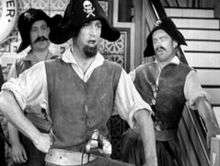Cinesound Varieties
Cinesound Varieties is a 1934 Australian variety short film from director Ken G. Hall made to go out on a double-bill with the full-length feature, The Silence of Dean Maitland (1934). Only 18 minutes of the film survive today.[2]
| Cinesound Varieties | |
|---|---|
 Still from the film | |
| Directed by | Ken G. Hall |
| Produced by | Ken G. Hall |
| Written by | Vic Roberts George D. Parker |
| Starring | Fred Bluett |
| Cinematography | Frank Hurley |
Production company | |
Release date | May 1934 |
Running time | 60 mins |
| Country | Australia |
| Language | English |
| Budget | £2,500[1] |
| Box office | £2,000[1] |
Synopsis
There were two main components of the film:
1) 'Evolution of a Waltz' - a musical presentation with Hamilton Webber and the State Orchestra illustrating the evolution of the waltz from the age of Mozart to Irving Berlin
2) 'Nautical Nonsense' - a musical comedy revue, featuring several Australian variety stars including
- Fred Bluett and his Boy Scouts story as pirates in Sydney
- the Tom Katz saxophone band
- soprano Angela Parselles[3]
- tap dancing by the Lowell brothers
- musical numbers by the Cinesound Octette
- the Cinesound Beauty Ballet of twenty Australian girls.
There were also appearances by Emanel Aarons at the grand organ and an adagio dance by the Orlandos.[4]
Production
The movie was made in two weeks in a local showground because Charles Chauvel was using Cinesound's studio for a film. There were also a number of scenes shot on Sydney harbour.[5]
"It was written in a hurry and it was a bad effort," said Hall later. "I'm not proud of it."[6]
Reception
Critical
Contemporary reviews were poor. The Sydney Morning Herald wrote that:
Pace is the essence of a variety show, and pace is what Cinesound Varieties definitely lacks... The text which holds everything together is painfully weak, and the humour deplorable. These are two points in which every Australian film so far, except On Our Selection has come desperately to grief; and, even in On Our Selection, the actors and the photographs had to triumph over unfavourable material. Talk of winning success in oversea markets will remain so much beating of empty air as long as producers continue to give text and narrative value last place in their attention, instead of putting these matters first. Sooner or later, the literary side of things must come into its own.[7]
"It is difficult to believe that Cinesound Varieties comes from the same studio as The Silence of Dean Maitland - if it did," said the reviewer from The Argus. "In it all those things that should not be done are done and all that should be done are left undone."[8]
"A sadly overdressed musical revue which has inherited all the evils the talkies were ever heir to, except the American slang," said The Advertiser.[9]
Box office
According to a contemporary trade report it is likely the film lost an estimated £1,200.[1]
References
- "Counting the Cash in Australian Films"', Everyones 12 December 1934 p 19-20
- Cinesound Varieties at Australian Screen Online
- "STARS OF THE AIR" TO SING "THE WORLD'S BEST TUNES". (22 June 1944). Kilmore Free Press (Kilmore, Vic. : 1870 - 1954), p. 7. Retrieved 12 November 2011
- 'AUSTRALIAN FILM. Proposed Musical Production', The Sydney Morning Herald, Thursday 15 February 1934 p 6
- Vagg, Stephen (23 December 2019). "Australian Film Musicals You Probably Didn't Realise Existed". Filmink.
- Philip Taylor, 'Ken G. Hall', Cinema Papers January 1973 p 81
- 'FILM REVIEWS "THE PRIVATE LIFE OF HENRY VIII."', The Sydney Morning Herald, Monday 4 June 1934 p 3
- 'Hoyts de Luxe DEAN MAITLAND WINS Fine Australian Picture', The Argus (Melbourne), Monday 18 June 1934 p 5
- 'THIS WEEK'S SHOWS', The Advertiser (Adelaide) Wednesday 27 June 1934 p 11
External links
- Cinesound Varieties in the Internet Movie Database
- Cinesound Varieties at National Film and Sound Archive
- Cinesound Varieties at Australian Screen Online
- Cinesound Varieties at Australian Variety Theatre Archive. Retrieved 27 January 2018.